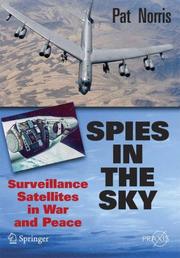| Listing 1 - 2 of 2 |
Sort by
|

ISBN: 1281133531 9786611133535 0387716734 0387716726 Year: 2008 Publisher: Berlin ; New York : Chichester, UK : Springer ; In association with Praxis Publishing,
Abstract | Keywords | Export | Availability | Bookmark
 Loading...
Loading...Choose an application
- Reference Manager
- EndNote
- RefWorks (Direct export to RefWorks)
In Spies in the Sky Patrick Norris responds to the occasion of the 50th Anniversary of the dawn of the Space Age – the launch of Sputnik 1 – with a review of the most important historical applications of space science for the benefit of the human race during that half century, focusing particularly on the prevention of nuclear war. The author addresses the oft quoted conclusion that the Moon landings and the ‘race to the Moon’ between the two superpowers were a side effect of the Cold War, by describing what he believes was the more important event – the use of satellites by military to prevent the Cold War becoming a ‘hot war’. In developing the story the author casts a spotlight on a little-known aspect of the Space Age, namely the military dimension. Today military satellites represent 25 percent of all satellites in orbit, and they are just as important now in preventing regional nuclear war as they were in preventing global Armageddon more than 30 years ago.
Military intelligence. --- Communications, Military --- Military surveillance. --- Aerial reconnaissance. --- Astronautics, Military. --- Artificial satellites. --- History. --- Artificial satellites --- Earth satellites --- Orbiting vehicles --- Satellite vehicles --- Satellites, Artificial --- Space vehicles --- Anti-satellite weapons --- Surveillance, Military --- Detectors --- Military intelligence --- Communications, Naval --- Military communications --- Naval communications --- Communication and traffic --- Information warfare --- Intelligence service --- Deception (Military science) --- Astronautics, Naval --- Military astronautics --- Naval astronautics --- Space control (Military science) --- Reconnaissance, Aerial --- Military reconnaissance --- Aerial observation (Military science) --- Astronomy. --- Astrophysics. --- Astronautics. --- Engineering. --- Popular Science in Astronomy. --- Space Sciences (including Extraterrestrial Physics, Space Exploration and Astronautics). --- Aerospace Technology and Astronautics. --- Engineering, general. --- Construction --- Industrial arts --- Technology --- Space sciences --- Aeronautics --- Astrodynamics --- Space flight --- Astronomical physics --- Astronomy --- Cosmic physics --- Physics --- Space sciences. --- Aerospace engineering. --- Aeronautical engineering --- Astronautics --- Engineering --- Science and space --- Space research --- Cosmology --- Science
Book
ISBN: 3319685333 3319685325 Year: 2018 Publisher: Cham : Springer International Publishing : Imprint: Springer,
Abstract | Keywords | Export | Availability | Bookmark
 Loading...
Loading...Choose an application
- Reference Manager
- EndNote
- RefWorks (Direct export to RefWorks)
This book addresses surveillance in action-related applications, and presents novel research on military, civil and cyber surveillance from an international team of experts. The first part of the book, Surveillance of Human Features, reviews surveillance systems that use biometric technologies. It discusses various novel approaches to areas including gait recognition, face-based physiology-assisted recognition, face recognition in the visible and infrared bands, and cross-spectral iris recognition. The second part of the book, Surveillance for Security and Defense, discusses the ethical issues raised by the use of surveillance systems in the name of combatting terrorism and ensuring security. It presents different generations of satellite surveillance systems and discusses the requirements for real-time satellite surveillance in military contexts. In addition, it explores the new standards of surveillance using unmanned air vehicles and drones, proposes surveillance techniques for detecting stealth aircrafts and drones, and highlights key techniques for maritime border surveillance, bio-warfare and bio-terrorism detection. The last part of the book, Cyber Surveillance, provides a review of data hiding techniques that are used to hinder electronic surveillance. It subsequently presents methods for collecting and analyzing information from social media sites and discusses techniques for detecting internal and external threats posed by various individuals (such as spammers, cyber-criminals, suspicious users or extremists in general). The book concludes by examining how high-performance computing environments can be exploited by malicious users, and what surveillance methods need to be put in place to protect these valuable infrastructures. The book is primarily intended for military and law enforcement personnel who use surveillance-related technologies, as well as researchers, Master’s and Ph.D. students who are interested in learning about the latest advances in military, civilian and cyber surveillance.
Political science. --- Politics and war. --- Pattern recognition. --- Biometrics (Biology). --- System safety. --- Computer crimes. --- Political Science and International Relations. --- Military and Defence Studies. --- Cybercrime. --- Pattern Recognition. --- Biometrics. --- Security Science and Technology. --- Computers and crime --- Cyber crimes --- Cybercrimes --- Electronic crimes (Computer crimes) --- Internet crimes --- Crime --- Privacy, Right of --- Safety, System --- Safety of systems --- Systems safety --- Accidents --- Industrial safety --- Systems engineering --- Biological statistics --- Biology --- Biometrics (Biology) --- Biostatistics --- Biomathematics --- Statistics --- Design perception --- Pattern recognition --- Form perception --- Perception --- Figure-ground perception --- War --- War and politics --- Administration --- Civil government --- Commonwealth, The --- Government --- Political theory --- Political thought --- Politics --- Science, Political --- Social sciences --- State, The --- Prevention --- Statistical methods --- Political aspects --- Electronic surveillance. --- Video surveillance. --- Military surveillance. --- Surveillance, Military --- Detectors --- Military intelligence --- Electronic surveillance --- Video recording --- Electronics in surveillance --- SIGINT (Electronic surveillance) --- Signals intelligence --- Surveillance, Electronic --- Remote sensing --- Optical pattern recognition. --- Optical data processing --- Pattern perception --- Perceptrons --- Visual discrimination
| Listing 1 - 2 of 2 |
Sort by
|

 Search
Search Feedback
Feedback About UniCat
About UniCat  Help
Help News
News